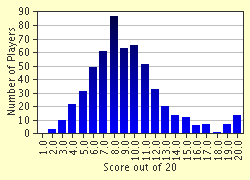Quiz Answer Key and Fun Facts
1. Name the basic unit of a Macedonian phalanx.
2. The Bactrian (that is, two-humped) camel was used primarily for warfare.
3. How many rows of oars did a Roman "trireme" have?
4. What was the name Hannibal's elephant?
5. Name the Roman throwing spear.
6. How many cohorts were in a 1st and 2nd century AD Roman legion?
7. What name was given to the Roman legion's shield formation used mainly against fortified positions?
8. What does "kataphraktoi" mean?
9. What was a "corvus" (in warfare)?
10. Where was the final naval encounter during Pompey's campaign against the pirates?
11. Where did the Hoplite take his name from?
12. Where did a Peltast get his name from?
13. Which unusual items of warfare did Caesar find in Britain?
14. The Assyrians ruled their empire by terror alone.
15. Was the "sambusa" a siege engine?
16. Who was the first to organise a siege train?
17. Which Ancient Wonder was made from the profits of selling a siege engine?
18. How many Jews survived the storming of Masada?
19. Who commanded an Augustan legion?
20. Which Egyptian mercenaries later guarded the Valley of the Kings?
Source: Author
Mortifer
This quiz was reviewed by FunTrivia editor
bloomsby before going online.
Any errors found in FunTrivia content are routinely corrected through our feedback system.

